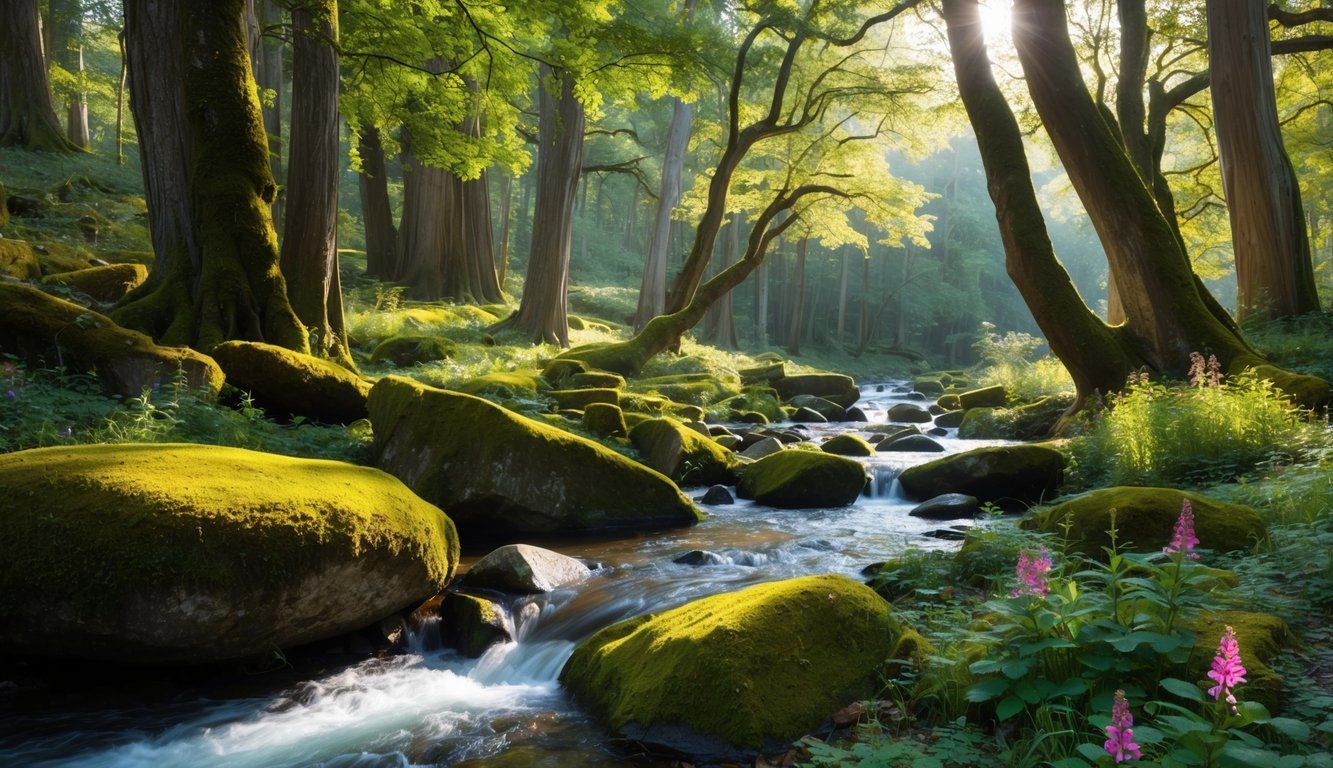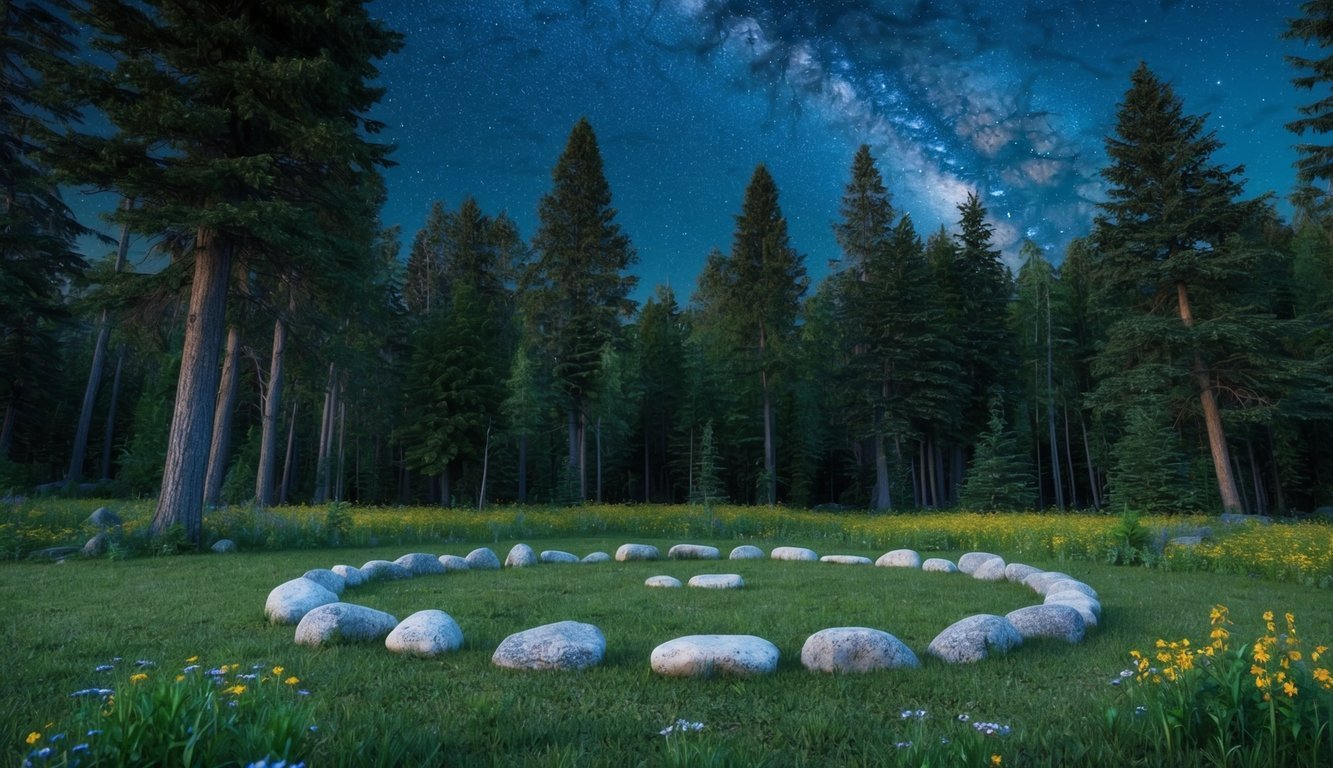PsychNewsDaily Publishers
100 Summit Drive
Burlington, MA, 01803
Telephone: (320) 349-2484
PsychNewsDaily Publishers
100 Summit Drive
Burlington, MA, 01803
Telephone: (320) 349-2484

Nature spirituality connects people to both the natural world and their inner selves. It invites a sense of peace and understanding through the beauty of nature. This approach emphasizes that spending time outdoors can deepen one’s spirituality and enhance intuition.
Many believe that nature offers ways to nurture relationships with the Earth. It encourages mindful practices like meditation among trees or the simple act of gardening. Engaging with nature allows individuals to experience the world in a more meaningful way, enriching their spirits and fostering a deeper connection to life itself.
Exploring nature spirituality can lead to transformative experiences. By integrating natural elements into daily life, people can find joy and calmness. This helps them to feel more grounded and connected to their surroundings.

Nature spirituality connects people to the Earth and all living things. It draws on cultural traditions and beliefs, often blending science with spiritual ideas. This section explores the historical roots and the theological perspectives that shape this way of understanding spirituality.
Many indigenous peoples have long recognized a deep connection with nature. For them, the Earth is more than just a resource; it holds spirit, or mana, which is vital in many cultures.
Animism, a belief that all beings have a spirit, is common among these communities. This worldview emphasizes respect and harmony with the natural world.
Traditions passed down through generations teach the importance of living sustainably and honoring the Earth. These teachings often include rituals and practices that celebrate the cycles of nature, such as planting and harvesting.
Theological views on nature spirituality vary among different religions. Many faiths emphasize the connection between God and creation. For example, in some traditions, God is seen as present in nature, inspiring awe and reverence for the Earth.
Ecology plays a significant role in these perspectives. Many theologians argue that caring for the environment is a spiritual duty. Protecting nature reflects a commitment to their beliefs.
Modern movements often combine these spiritual and ecological insights. They seek to bring awareness to environmental issues through a spiritual lens. This blend encourages a deeper appreciation for the interconnectedness of all living things.

Nature spirituality manifests in various forms, allowing individuals to connect deeply with the natural world. This section highlights how art, music, rituals, and gardens serve as expressions of this spirituality.
Art and literature often draw inspiration from nature. Many artists paint breathtaking landscapes to capture the beauty of the natural world. These pieces can evoke feelings of peace and appreciation for the earth.
Literature also reflects nature spirituality. Writers weave themes of nature into their stories, poetry, and essays. This can inspire readers to see the interconnectedness of life. Works like Walden by Henry David Thoreau explore human relationships with the natural world.
Music plays a significant role in expressing nature spirituality. People often use singing and instruments to celebrate the cycles of nature. Songs about the seasons or specific plants and animals foster a sense of connection to the earth.
Rituals are also essential. Many cultures hold ceremonies that honor nature, such as planting festivals or harvest celebrations. These rituals create a shared experience, bringing communities together to connect with the earth and its rhythms.
Gardens serve as a physical embodiment of nature spirituality. They provide spaces for reflection, growth, and connection. A simple garden can become a sanctuary, where individuals experience the cycles of life and nature.
In urban areas, parks and community gardens can offer similar benefits. These spaces allow city dwellers to engage with nature amidst the hustle of daily life. They create a sense of calm and promote well-being, reminding people of the importance of nature in their lives.

Nature is a complex and beautiful system where everything is connected. This connection can be seen in ecosystems, where various species rely on one another. It also includes the relationships between animals and plant life, playing a crucial role in sustaining the environment.
Ecosystems are made up of living organisms and their surroundings. Each ecosystem contains diverse species that contribute to its health. For example, forests, oceans, and grasslands are different ecosystems.
Biodiversity refers to the variety of life in these ecosystems. A rich diversity of plants and animals helps create a balanced environment. It provides food, shelter, and resources for various species.
In many ecosystems, trees play a vital role. They provide oxygen, improve air quality, and offer habitats for many animals. Without biodiversity, ecosystems can struggle, leading to imbalance and decline.
Animals and plants are essential parts of the interconnected web of life. Plants, such as trees and flowers, are crucial for oxygen production and food sources. They rely on sunlight, soil, and water to thrive.
On the other hand, animals depend on plants for food and shelter. Pollinators, like bees and butterflies, help plants reproduce. This relationship is vital for many crops, allowing fruits and vegetables to grow.
Key Relationships:
These relationships highlight how closely connected animals and plants are. Together, they create a balanced and thriving environment.

Spiritual practices in nature offer a way to deepen one’s connection to the earth. They encourage mindfulness and foster a stronger sense of faith. Two key practices include meditation and grounding exercises, along with the significant roles of the sun and moon.
Meditation in nature allows a person to connect deeply with their surroundings. The sound of rustling leaves or flowing water enhances the experience. Many people practice mindfulness by focusing on their breath while observing the beauty around them.
Grounding exercises are another important aspect. This involves standing or sitting on the earth, feeling the ground beneath. It helps create a sense of stability and balance. Techniques can include visualization or simply noticing sensations in the body.
Both practices help reduce stress and increase awareness of one’s environment. Incorporating elements of nature into these exercises can enhance spiritual growth. Engaging with the natural world opens pathways for reflection and connection.
The sun and moon play significant roles in many spiritual traditions. For instance, the sun symbolizes illumination, energy, and life. Spending time in sunlight can boost mood and encourage a sense of renewal.
The moon, on the other hand, connects to cycles and intuition. Many practices involve moon phases, such as setting intentions during a new moon. Observing the moon helps deepen one’s spiritual journey.
Druids often emphasize the importance of these celestial bodies in their rituals. They celebrate natural cycles and the influence of the sun and moon on life. By paying attention to both, individuals can strengthen their spiritual practices in nature.

In today’s world, many people seek a deeper connection with nature amid the distractions of technology and modern living. Nature spirituality offers a way for individuals to find peace and meaning while promoting environmental awareness.
Life is often dominated by gadgets and screens. This constant connection can lead to stress and anxiety. Many seek solace by stepping outside and connecting with the natural world.
Creating a balance between technology and nature can enhance spiritual well-being. Here are a few ways to achieve this:
Finding opportunities to experience nature helps individuals feel calm and centered.
Eco-spirituality links spirituality with caring for the Earth. This approach encourages individuals to see nature as sacred and worthy of protection.
The rise of climate change has made this connection even more critical. Many now view their spiritual journey as tied to environmental activism. Here are some ways people can get involved:
Engaging in eco-spirituality empowers individuals to take action for a healthier planet while nurturing their spiritual journey.

Nature spirituality is a rich field that invites individuals to explore their connections with the natural world. Here are some common questions people have about this topic.
There are many books that delve into nature spirituality. Some popular titles include “Braiding Sweetgrass” by Robin Wall Kimmerer and “The Hidden Life of Trees” by Peter Wohlleben. These books encourage readers to see the deep connections between themselves and the environment.
To strengthen their connection, individuals can practice mindfulness in nature. This can involve paying attention to the sights and sounds around them. Breathing exercises and meditation outdoors can also enhance their spiritual experience.
Certainly! One inspiring quote is by John Muir, who said, “In every walk with nature, one receives far more than he seeks.” Another is from Albert Einstein: “Look deep into nature, and then you will understand everything better.” These quotes emphasize the wisdom found in nature.
Spending time in nature can reduce stress and promote a sense of peace. Many people find it helps them feel more connected to themselves and the world around them. This connection can lead to greater awareness and fulfillment in life.
Individuals can practice nature spirituality by taking regular walks in parks or forests. Gardening or simply spending time outside can also enhance this practice. Engaging in nature-based rituals or activities is another way to connect spiritually with the environment.
A person who reveres nature in this way is often referred to as a “nature spiritualist” or “nature worshiper.” These individuals see nature as integral to their spiritual beliefs and practices. They value the environment as a source of inspiration and connection to the divine.